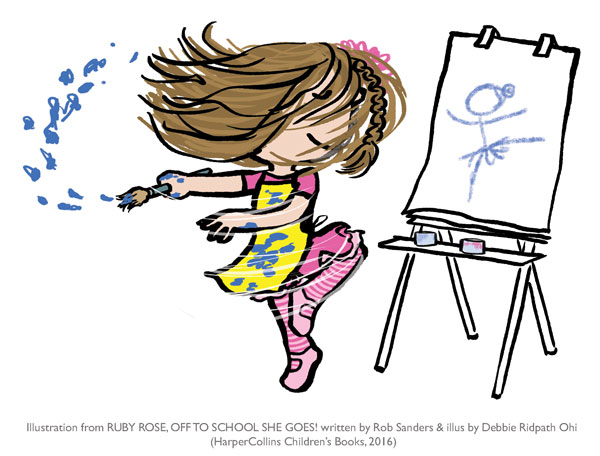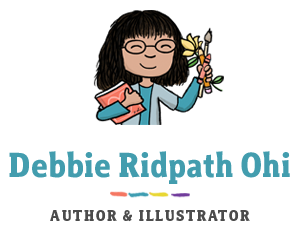For more advice and resources, please visit my main FAQ: Answers To Frequently Asked Questions, especially my top pieces of advice for those who want to write or illustrate books for young people someday.

I’ve been asked this many times but have postponed adding something “official” to my main FAQ because I never really felt qualified; I began as a writer and don’t have any art training, after all, and my career path is not typical. Since I was approached about my first children’s book back in 2010, however, I’ve illustrated quite a few books include picture books, chapter books, and covers. I have worked with editors and art directors at Simon & Schuster, Random House, HarperCollins, Little Brown and others, and have also had many conversations with fellow children’s book illustrators, so I’ve decided that I do have enough experience at this point to offer some advice. ? Keep in mind that there are always exceptions and different possible paths to publication. Many illustrators do find success and continue to be successful despite not following any of the so-called rules or pieces of advice below. HOWEVER, especially these days (I am writing this during the pandemic), it can be a challenge for illustrators to break into the children’s book illustration market, so keeping some of the points below in mind may be able to help you get noticed sooner than others.
Advice for those who are starting to think about illustrating books for young people someday:
Be aware that artistic talent alone is not enough. There are MANY talented artists out there (and frankly, most are way more talented than I am) but that does not necessarily make them good illustrators for children’s books. Agents, editors and art directors are usually looking for artists who understand children’s book format as well as children’s book illustration.
READ as many illustrated children’s books as you can, especially the type you are most interested in illustrating: picture books, chapter books, graphic novels, etc. Become familiar with the types of illustrated books that are being published today. Read for pleasure, read to analyze. Become familiar with different children’s book publishers and what types of books they’re publishing.
Get to know others in the children’s book community. While writing and illustrating are solitary activities, trying to get published doesn’t have to be. Seek out your local kidlit and/or illustrator community. Join the SCBWI (and seek out your regional chapter) and CANSCAIP if you’re in Canada. Don’t just focus on meeting VIPs (art directors, editors, agents, etc). Not only will you be more relaxed and have more fun, you may make some friends along the way. Instead of angsting about not being invited to join a particular already established group of creators, consider forming your own for mutual support and exchange of advice.

Be prepared to do the work. There is no magic shortcut. Keep working on your craft. No matter what stage you are in your career, you can always be learning and improving.

Find a good critique partner or critique group. Aim to find a group whose members are around the same stage or further along in their careers OR more advanced in their work. Not sure where to look for critique partners? Getting to know others in the community via SCBWI and CANSCAIP is a good place to start.
Analyze as many picture books as you can. Read for enjoyment, of course, but also read to improve your understanding of the craft and format. Many know that 32 pages is a standard for picture books, but this doesn’t necessary mean that all 32 pages are available for story and illustration. Also, you don’t have to have one illustration per page; learn to understand the difference between full spreads, spot illustrations and other ways to illustrate a story. I’ve seen too many picture book dummies with exactly one illustration per page, no visual variety in format.
If you are approached by a picture book writer who asks you to illustrate their book before they approach a publisher, be aware that in most cases, traditional publishers prefer finding the illustrator themselves. There are many reasons for this (see I just finished writing my picture book story. How do I find an illustrator? for some), but of course there are always exceptions. If you decide to go ahead and partner with a writer anyway, keep in mind that an editor may want to acquire the text manuscript but decide to find another illustrator. Will you and the author be okay with this? It’s a conversation to have before you start submitting your collab book.
When putting together your portfolio, whether online or a physical portfolio, try to limit the number of illustration styles being showcased to one or two, even if you have multiple illustration styles. More is fine if you are 100% confident you do them well BUT be aware that if your portfolio looks too jumbled or incoherent, it may turn off industry people. One of the main critiques I had for my first portfolio was exactly that: I had too many illustration styles. However, there are always exceptions – I did end up getting my first children’s book illustration contract.

It’s easy for most illustrators to pick a one-off showcase piece. However, picture book illustrators need to also be able to show they can draw a character that looks consistent over a series of illustrations. So another piece of advice: in your portfolio, include a sequence of 2 or 3 illustrations in which you show the same character or characters in action (not just standing smiling at the camera), to prove you can draw a consistent-looking character.
Try to avoid too many “greeting card style” pieces in your portfolio. I made this mistake in my first portfolio: pieces that basically looked like they could be greeting cards instead of illustrations for a picture book. I’ve also noticed this in many beginning portfolios when critiquing – one-offs that are basically headshots of characters smiling at the camera.
Vary the camera angles and composition of the pieces in your portfolio. Avoid having all your pieces look like they were taken from exactly the same angle/camera. Examples: close-up, zoomed out, birds-eye view, viewpoint of a child, angled view, etc. If you lean toward elaborate and detailed backgrounds, for example, consider including a piece or two that is much simpler and closer-up with a simpler background, just for visual variety.
Have characters interacting and reacting. Avoid having all your pieces just feature ONE character looking at the camera. One way you can avoid greeting card style pieces is to show the character in a setting where they need to be doing something or reacting to something or someone. Show different emotions. Yes, your cute and happy characters may get a ton of Likes in social media, but you want to show that you can convey different moods and emotions. One common mistake I’ve noticed in beginner portfolios is showing only happy, smiling characters.
Try to include pieces that make the viewer want to find out the story behind them, or wonder what happens next. And if an agent approaches you and asks, “Do you have a story to go with this image?” you want to say YES. 🙂
Show that you can draw backgrounds. This was my weakness in my first portfolio; I hated drawing backgrounds, so many of my pieces were basically a character or characters with nothing in the background. Of course there ARE illustrators out there who are successful with this kind of simple illustration, but you will increase your appeal to editors and art directors if you can show you CAN draw backgrounds. Bonus: if you can also show that you have a mastery of conveying light and atmosphere in your backgrounds.
When choosing themes and subjects, keep in mind the type of book you want to illustrate. Including your award-winning illustration of a grizzled old politician chain-smoking may not be the best way to show your understanding of the children’s book industry. If your goal is to illustrate picture books, include kids in at least some of your pieces to show how you draw them. Show them in kid-friendly situations. Or if you’d rather draw animals, include those — but again, keep illustrative style in mind. Do you lean toward realism or more cartoon-y? What kind of work do you want? Again, you can get a sense of what kind of illustrative styles are being used in children’s books by looking at what’s out there.
Focus on including the kind of art you want to be hired for. You may be especially proud of that complex piece that took a zillion hours to do or that mixed media collage that got so much love on social media, but I would strongly advise ONLY including it in your portfolio if you’re interested in doing an entire picture book using that style.
There is a ton of portfolio advice from children’s book illustrators and other industry people online. I recommend also going to Kidlitartists.com and searching for the word “portfolio” as well as “portfolio advice“. You’ll find plenty of tips from those who have won portfolio awards at the SCBWI conferences.
There are always exceptions, of course! So much is subjective in the industry.
This is Part 1 of my advice for beginning children’s book illustrators because I also plan to write an updated post with advice about how illustrators can get noticed.
And as I mentioned at the beginning: for more advice and resources, please visit my main FAQ: Answers To Frequently Asked Questions, especially my top pieces of advice for those who want to write or illustrate books for young people someday.

